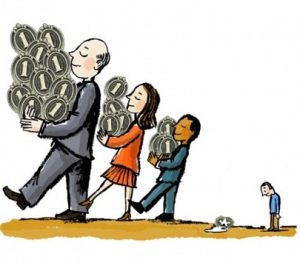In economics, ‘Pareto efficiency’ is a term which is used to describe allocation of resources which does not necessarily result in satisfying each individual’s wants. Pareto efficiency means socially required distribution of resources does not occur. Social equality and overall well-being is a rare phenomenon. The notion of Pareto efficiency can also be applied to the selection of alternatives in engineering and similar fields. Pareto’s efficiency is also called Pareto’s optimality. The term simply means that it is difficult to make any one individual better off without making at least one individual worse off. The theory is named after Vilfredo Pareto, an Italian engineer and economist, who used the concept in his studies of economies efficiency and income distribution.
The concept Pareto efficiency describes that in state’s economy resources are distributed in such manner that it is not possible to improve a single individual without also causing at least one other individual to become worse off than before the change. When evaluating proposed or existing policy measures, economists & government officials typically aim to improve the lives of others. The objective of any given tax, welfare, or law change is to improve the lives of many citizens while not worsening the lives of others. The most ideal policies improve the lives of others without making anyone else worse off. This is what we refer to as Pareto efficiency.
Let’s take example of the card game Rummy, in which two players put in their stake; one person earns both player’s stakes, his own and the others. Pareto efficiency has applications in game theory, which is related to multi-criteria decision making. It has application in engineering, and many of the social sciences too.
The Game Theory in the branch of mathematics, which is concerned with the analysis of strategies for dealing with competitive situations, depends on the outcome of a participant’s choice of action depends. The decisions depend critically on the actions of other participants. Game theory has been applied to contexts in business strategies, war, science and biology. What economists call game theory psychologists call the theory of social situations, which is an accurate description of what game theory is about. Although game theory is relevant to parlor games such as poker or bridge, most research in game theory focuses on how groups of people interact.
In general, an economic allocation problem has several possible Pareto efficient outcomes. In the marketplace, the competitive equilibrium is typically included among them. A major drawback of Pareto efficiency, some ethicists (people who judge on the basis of ethics) claim, is that it does not suggest which of the Pareto efficient outcomes is best. Furthermore, the concept does not require an equitable distribution of wealth, nor does it necessarily suggest taking remedial steps to correct for existing inequality. The concept suggests that if the incomes of the wealthy increase while the incomes of everyone else remain stable, such a change is Pareto efficient. The simplest example to describe Pareto efficiency is: there are two persons. One has two mangoes and one has two bananas. Three of the allocations suggest Pareto efficient situations: (1) person 1 has all the mangoes and person 2 has all the bananas (2) person 1 has all mangoes and all bananas (3) person 2 has all mangoes and all bananas.
One more example is: imagine that you and your friend are walking down the street and find a $100 bill. You would likely share the money evenly, each taking $50, deeming this the fairest division. According to Pareto efficiency, however, any allocation of the $100 would be optimal, it could be that you would like to keep all $100 for yourself or you would give it all to your friend. I hope you understood that the fairest division doesn’t take place.
‘Pareto improvement’ is a concept that describes actions which benefits even a single person without harming anyone else. This is possible to implement by utilizing idle resources in the economy or by getting rid of burden losses that result of market failure. For example to build a new airport in a city may lead to a greater increase in social benefit than social cost. Therefore, there is a net gain to society. However, those people living near the new airport will lose out their peace of mind. Therefore this is not a Pareto improvement. An outcome may be seen as a Pareto improvement, but, it doesn’t mean this is a satisfactory outcome for those living near the airport. Inequality exists even after a Pareto improvement. It cannot be said that perfect efficiency has been achieved if there is scope for even a single Pareto Improvement.
In real-world, in liberalized economies, where the rich will go on becoming richer and poor will remain poor Pareto efficiency exists. System of free markets will lead to a Pareto efficient outcome. Since the notion of Pareto efficiency is not connected with the notion of equity, this result does not imply that a competitive equilibrium is equitable. The Pareto principle (also known as the 80/20 rule, the law of the vital few, which states that the riches of a nation are distributed between 20% of its population and 80% still remain poor is indirectly related to Pareto efficiency.














































